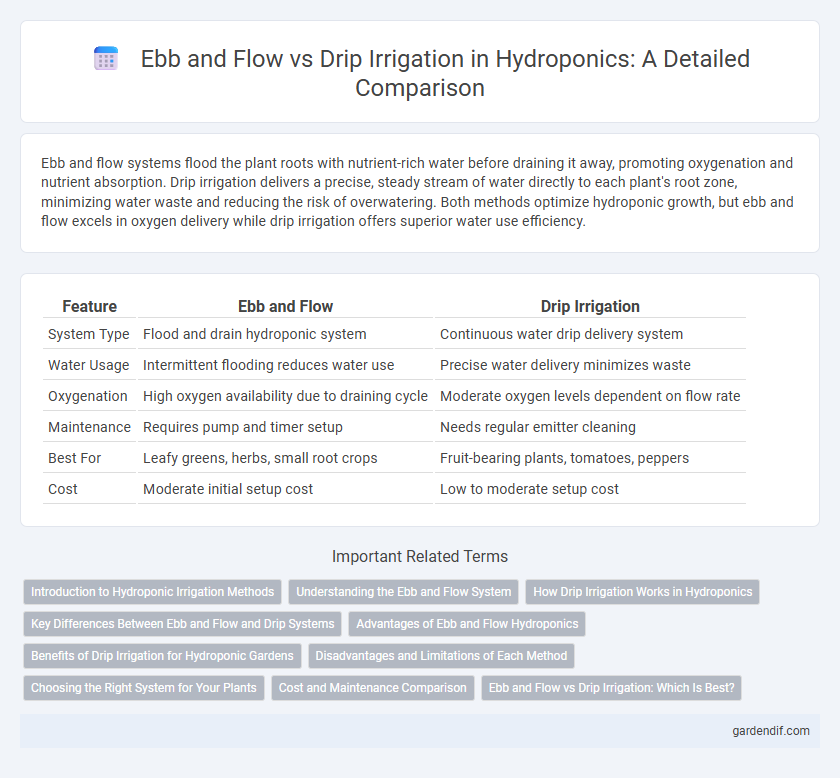
Ebb and flow vs Drip irrigation Illustration
Ebb and flow systems flood the plant roots with nutrient-rich water before draining it away, promoting oxygenation and nutrient absorption. Drip irrigation delivers a precise, steady stream of water directly to each plant's root zone, minimizing water waste and reducing the risk of overwatering. Both methods optimize hydroponic growth, but ebb and flow excels in oxygen delivery while drip irrigation offers superior water use efficiency.
Table of Comparison
| Feature | Ebb and Flow | Drip Irrigation |
|---|---|---|
| System Type | Flood and drain hydroponic system | Continuous water drip delivery system |
| Water Usage | Intermittent flooding reduces water use | Precise water delivery minimizes waste |
| Oxygenation | High oxygen availability due to draining cycle | Moderate oxygen levels dependent on flow rate |
| Maintenance | Requires pump and timer setup | Needs regular emitter cleaning |
| Best For | Leafy greens, herbs, small root crops | Fruit-bearing plants, tomatoes, peppers |
| Cost | Moderate initial setup cost | Low to moderate setup cost |
Introduction to Hydroponic Irrigation Methods
Ebb and flow and drip irrigation are two primary hydroponic irrigation methods that optimize nutrient delivery to plants. Ebb and flow systems periodically flood the grow tray with nutrient solution before draining it, promoting oxygenation and efficient root hydration. Drip irrigation delivers a continuous, controlled stream of nutrient solution directly to each plant's root zone, maximizing water use efficiency and minimizing waste.
Understanding the Ebb and Flow System
The ebb and flow system in hydroponics operates by periodically flooding the grow tray with nutrient solution before draining it back into the reservoir, promoting oxygenation of plant roots and efficient nutrient uptake. Unlike drip irrigation, which constantly delivers a slow, steady flow of nutrients, ebb and flow cycles create alternating wet and dry periods that enhance root aeration and prevent waterlogging. This method is particularly effective for growing a wide range of crops, as it balances water and oxygen availability to optimize plant growth.
How Drip Irrigation Works in Hydroponics
Drip irrigation in hydroponics delivers nutrient-rich water directly to the plant roots through a network of tubes and emitters, ensuring precise control over moisture and nutrient delivery. This method minimizes water waste and reduces the risk of root diseases by preventing waterlogging. Unlike ebb and flow systems that flood and drain the entire growing medium, drip irrigation maintains a consistent moisture level tailored for each plant's needs.
Key Differences Between Ebb and Flow and Drip Systems
Ebb and flow hydroponic systems periodically flood and drain the grow tray, allowing plant roots to receive nutrients and oxygen in cycles, while drip irrigation continuously delivers a slow, steady drip of nutrient solution directly to each plant's root zone. The ebb and flow system is typically more water- and energy-efficient due to its cyclical nature, whereas drip systems offer precise control over watering frequency and volume, making them ideal for crops with varied moisture needs. Maintenance differs as ebb and flow requires a reliable pump and timer for flooding cycles, while drip systems rely on emitters that can clog and need regular inspection to ensure consistent nutrient delivery.
Advantages of Ebb and Flow Hydroponics
Ebb and flow hydroponics offers superior oxygenation to plant roots by periodically flooding and draining the grow tray, promoting robust root growth and nutrient uptake. This system is energy-efficient, utilizing a single pump on a timer which reduces overall electricity consumption compared to continuous drip irrigation. Its simplicity and low maintenance make it ideal for various crop types, providing consistent moisture without waterlogging or nutrient buildup.
Benefits of Drip Irrigation for Hydroponic Gardens
Drip irrigation in hydroponic gardens delivers precise water and nutrient control directly to plant roots, enhancing growth efficiency and conserving resources. Its ability to minimize water waste and reduce the risk of root diseases makes it ideal for various hydroponic systems, including NFT and deep water culture. The customizable flow rates and scalability of drip irrigation support optimized plant health and higher yields in controlled environment agriculture.
Disadvantages and Limitations of Each Method
Ebb and flow systems are prone to root diseases due to periodic waterlogging, and their mechanical components require regular maintenance to prevent pump failures. Drip irrigation faces issues such as clogging of emitters, which can disrupt nutrient distribution and require frequent cleaning. Both methods may struggle with uniform nutrient delivery, potentially affecting plant growth if not carefully monitored.
Choosing the Right System for Your Plants
Ebb and flow systems flood the plant roots with nutrient solution before draining it away, promoting oxygenation and efficient nutrient uptake ideal for plants with moderate water needs. Drip irrigation delivers a continuous, precise flow of nutrients directly to the root zone, making it suitable for water-sensitive or high-value crops requiring consistent moisture levels. Selecting between ebb and flow and drip irrigation depends on plant species, growth stage, and environmental conditions to optimize water use efficiency and maximize yield.
Cost and Maintenance Comparison
Ebb and flow systems generally incur lower initial costs compared to drip irrigation due to simpler components and design. Maintenance needs are typically less intensive, as ebb and flow systems experience fewer clogging issues and require less frequent cleaning than drip emitters, which can be prone to blockage. Drip irrigation offers precise water delivery but often demands more regular inspection and replacement of emitters, leading to higher ongoing maintenance expenses.
Ebb and Flow vs Drip Irrigation: Which Is Best?
Ebb and flow systems excel in delivering nutrient-rich water through periodic flooding and draining cycles, promoting oxygenation and reducing water waste, ideal for leafy greens and herbs. Drip irrigation offers precise, continuous water delivery directly to plant roots, making it suitable for larger crops and minimizing disease risk through controlled moisture. Choosing between ebb and flow and drip irrigation depends on crop type, space, and water efficiency priorities in hydroponic setups.
Ebb and flow vs Drip irrigation Infographic

 gardendif.com
gardendif.com